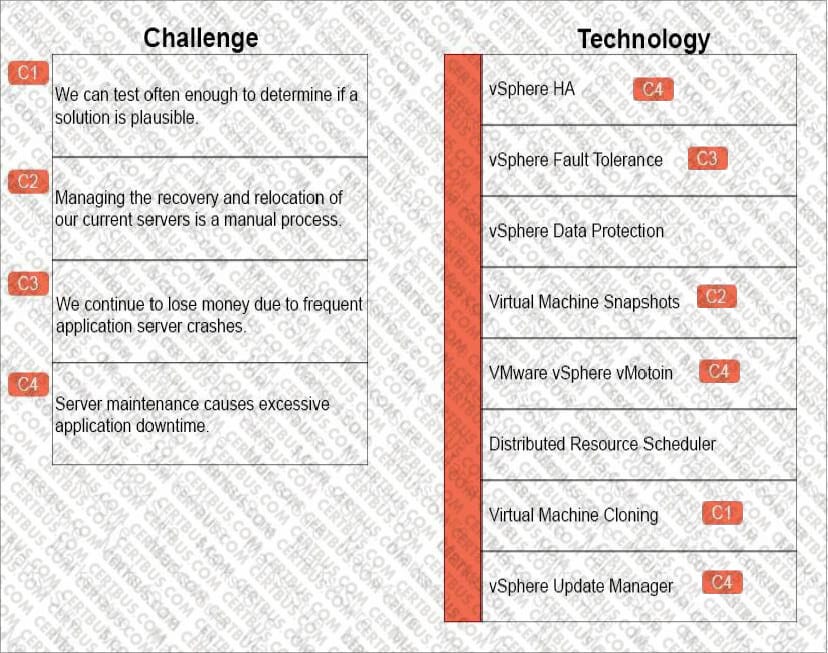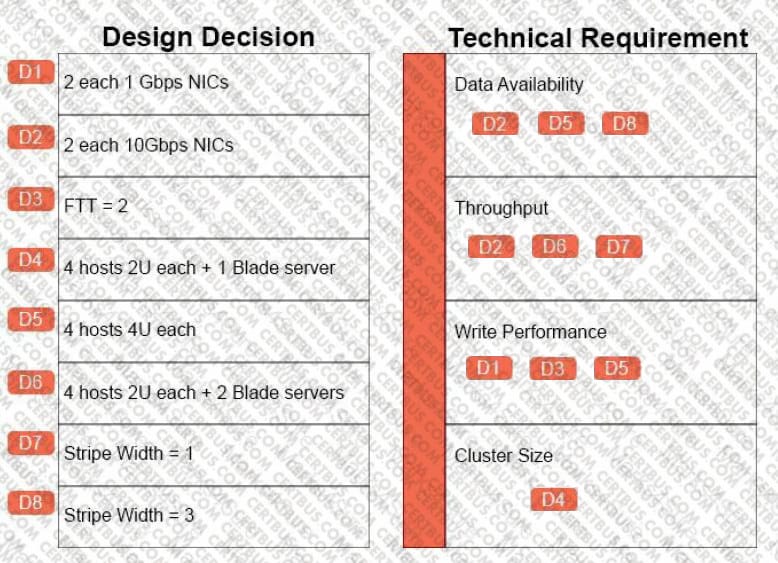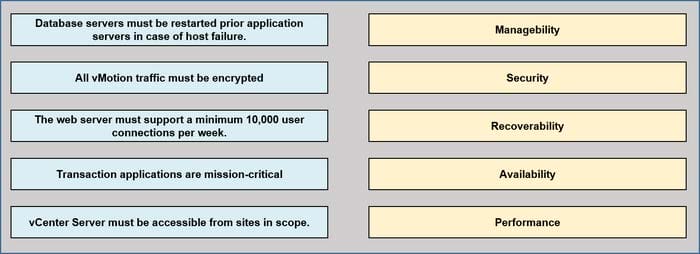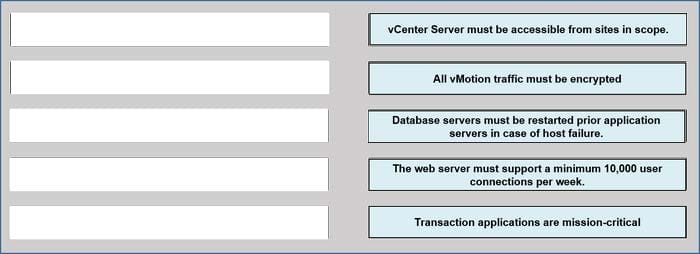3V0-624 Online Practice Questions and Answers
You have been tasked with creating a vSphere 6.5 data center design for an organization. The organization has identified a number of challenges that occur within their current infrastructure that they would like addressed in the design. For
each challenge, determine the vSphere technologies that could be used in the design.
Match each Challenge on the left by dragging the red Challenge buttons (C1-C4) over the appropriate Technology.
Select and Place:
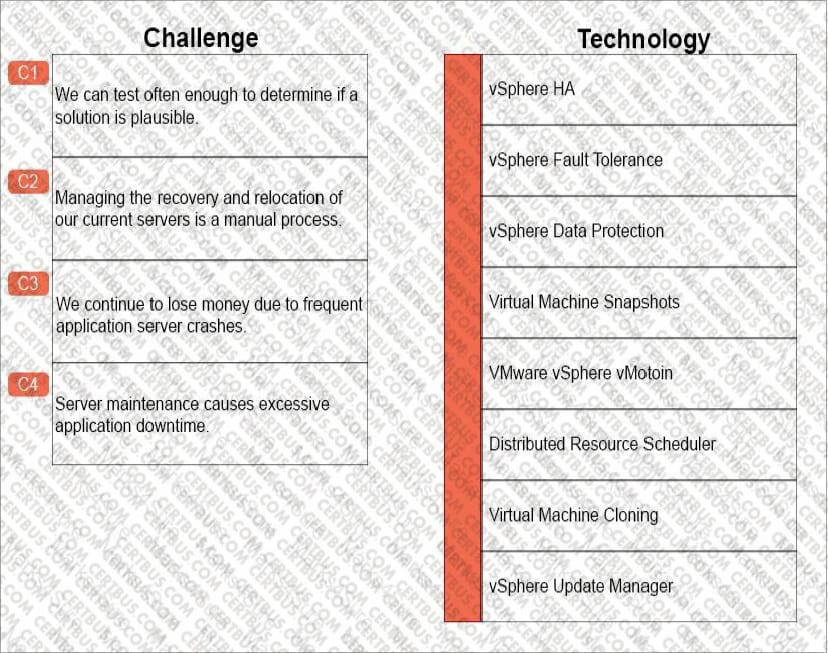
You have been tasked with creating a vSphere 6.5 design for an organization. The organization is looking to implement a Virtual SAN into their environment. You have been tasked with determining whether a given Virtual SAN logical design
decision meets the technical requirements of their infrastructure.
For each Design Decision on the left drag the red Decision buttons (D1-D8) on the right and place it on the proper Technical Requirement.
NOTE: Not all Design Decisions will be used.
Select and Place:
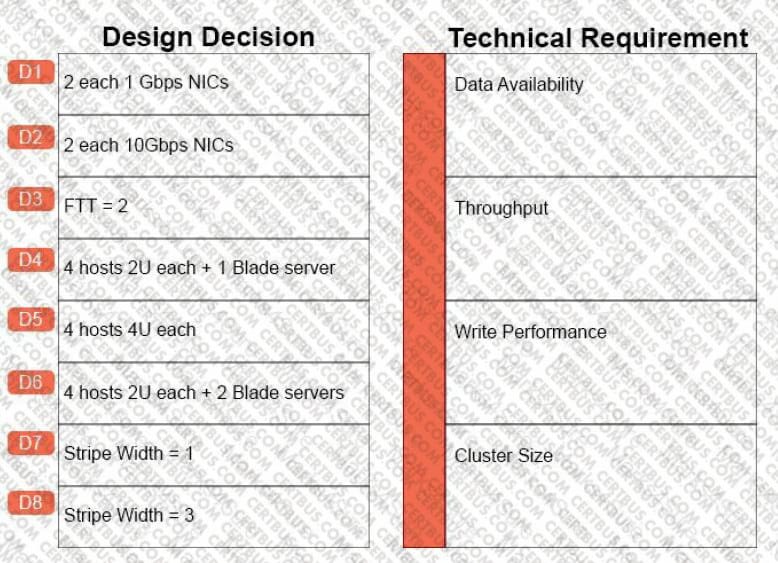
A company is in the process of deploying a modern video-streaming application.
1.
The application is able to scale (expand and collapse) its steaming nodes in the form of CentOS 7.x 64bit virtual machines, based on demand.
2.
This IO-Intensive application has a high CPU demand and generates a significant number of disk operations (IOPS).
3.
To host the application, the company decided to implement a brand-new VMware cluster with vSphere 6.5
4.
The company would like a significant reduction in CPU utilization as well as a possible increase in throughput.
Which virtual disk adapter should be recommended for the company's physical design?
A. LSI Logic Parallel
B. VMware Paravirtual
C. BusLogic Parallel
D. LSI Logic SAS
In order to provide a critical service, a customer needs four virtual machines (VMs), each with 55GB memory reservation.
1.
This service must NOT experience an outage due to host hardware failures or host maintenance.
2.
The customer has ESXi hosts with 256GB of RAM each and, for business reasons, must run this service in a new ESXi host cluster.
Which VMware-recommended solution meets the stated requirements?
A. * Create an ESXi host cluster with 3 ESXi hosts.
* Enable HA and DRS on the ESXi host cluster.
B. * Create an ESXi host cluster with 2 ESXi hosts.
* Enable HA and DRS on the ESXi host cluster.
C. * Enable Fault Tolerance for the 4 VMs.
* Create an ESXi host cluster with 2 ESXi hosts.
D. * Enable HA and DRS on the ESXi host duster.
E. * Enable Fault Tolerance for the 4 VMs.
*
Create an ESXi host cluster with 3 ESXi hosts.
*
Enable HA and DRS on the ESXi host cluster.
The hardware operations team is planning to purchase new ESXi hosts for the upcoming budget year and is requesting recommendations on the type of servers to purchase for a web application. The web application consists of hundreds of small virtual machines (1 vCPU and 8GB of RAM) that are members of a software cluster.
The solution should have these abilities:
1.
recover from ESXi host hardware failures
2.
zero downtime for a limited number of critical virtual machines (VMs)
3.
migrate running VMs between ESXi hosts without interruption to the operating system
4.
perform these functions using VMware ESXi servers, vCenter Server, and high-speed network interfaces
What are the three functional requirements and their associated VMware technologies? (Choose three.)
A. automatic restarts of failed VMs (vSphere HA)
B. high speed network interfaces (vSphere Distributed Switches)
C. ability to migrate running VMs (vSphere vMotion)
D. fault tolerance for limited number of critical VMs (vSphere FT)
E. VMware ESXi Servers (vSphere Auto Deploy)
A company would like to leverage snapshot technology on vSphere 6.5. Which configuration supports taking snapshots?
A. Windows Failover Cluster VM with RDM in virtual mode
B. vSphere Fault Tolerance VM
C. Windows Failover Cluster VM with RDM in physical mode
D. SQL Always On Availability Group
Which of the following needs to be considered when determining the amount and size of thehosts required for a virtual design?
A. Aggregate CPU and memory requirements
B. Future growth
C. Number of vCPUs to be hosted per box
D. All of the above
A systems architect has been asked to design the upgrade of a vSphere 5.5 to a 6.5 environment.
1.
The current vSphere environment has sites in Houston and New York, each with its own Single Sign-on domain.
2.
Each site also has a Windows vCenter Server
The business has requested these considerations during the upgrade design:
1.
One vSphere Single Sign-On domain
2.
vCenter Server configured in a highly available manner at each site
3.
reduce operating system licensing costs
4.
centralized repository for templates and ISOs
Which implementation order would satisfy these requirements?
A. Build out a new vSphere Single Sign-On domainDeploy a new Windows vCenter Server and use Microsoft ClusteringValidate from the VMware interoperability and third party matricesConfigure Content Library
B. Validate from the VMware interoperability and third party matricesUse the vSphere Migration Tool and enable vCenter High AvailabilityConsolidate the existing vSphere Single Sign-On domainConfigure Content Library
C. Validate from the VMware interoperability and third party matricesConsolidate the existing vSphere Single Sign-On domainUse the vSphere Migration Tool and enable vCenter High AvailabilityConfigure Content Library
D. Configure Content LibraryBuild out a new vSphere Single Sign-On domainValidate from the VMware interoperability and third party matricesDeploy a new Windows vCenter Server and use Microsoft Clustering
A university is going through an IT transformation project and is re-evaluating how to use technology to provide a better academic experience for its 15,000 students. The university is a current VMware customer and has a single data center.
1.
Within that data center, the university is using blade servers backed by a Fibre Channel array for its business critical applications
2.
It has two iSCSI arrays (one for the development environment and other for the no-critical production environment)
3.
The university's VMware environment consists of three clusters. The first cluster contains all development virtual machines (VMs), the second cluster is dedicated to DMZ VMs, and the final cluster contains production VMs
4.
The university requires the ability to perform hardware maintenance without a service interruption, and can only sustain 4 minutes of downtime per month
From the list below, which three are constraints? (Choose three.)
A. 99.9% uptime is required for the environment
B. The Network Operation Center uses SolarWinds for all monitoring and alerting
C. Blade servers must be used to consolidate space
D. Provide capacity to support 20% Year-over-Year growth for the next 3 years
E. There area current contracts in place with Dell to provide all server hardware

